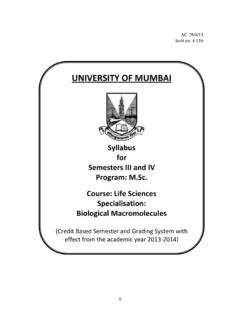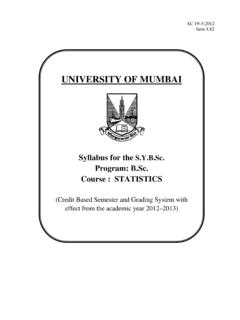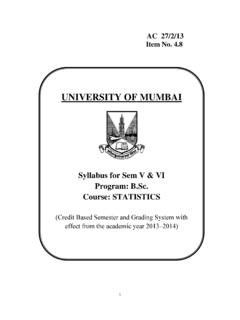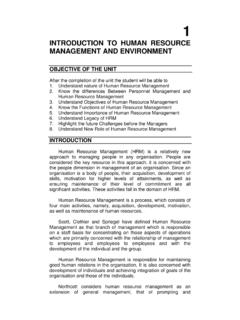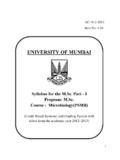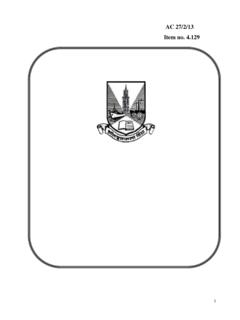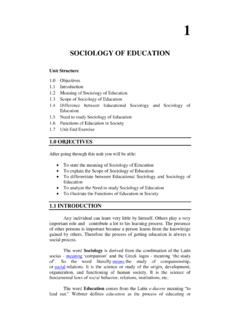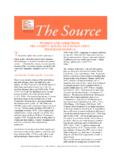Transcription of UNIVERSITY OF MUM BAI
1 UNSy (CrediteffeNIVER yllabus PCou t Based Sect from RSITYfor SePrograurse: B Semestethe acadY OF em III am: MBio-Cheer and Grdemic ye F MUM and emistryrading Sear 2013 MBAIem IV y System w3 2014) AC 27 Item no. I with 7/2/13 2 Th e ory SEMESTER III Course Code UNIT TOPIC HEADINGS Credits L / Week PSBCH301 I Overview of classical Genetics, Nature of genetic material 4 1 II Structure and characteristic of DNA & RNA, Organization of DNA in genome, Functions of gene 1 III Cell cycle and its regulation , Replication of DNA 1 IV Transcription of DNA, Translation (Protein Biosynthesis) 1 PSBCH302 I Introduction to Immune system, Cell and organs of Immune system 4 1 II Antigens and antibodies, organization, MCA and expression of immunoglobulin gene and its regulation 1 III Antigen antibodies interaction 1 IV Molecules involved in Immunology, MHC and complement system.
2 1 PSBCH303 I Carbohydrate metabolism and related disorders 4 1 II Lipid metabolism and related disorders 1 III Protein metabolism and related disorders 1 IV Nucleotide metabolism and related disorders 1 PSBCH304 I Macronutrients of Nutritional significance 4 1 II Techniques in Nutrition 1 III Nutrigenomics 1 IV Community Nutrition 1 PSBCHP301 Isolation of DNA and RNA 2 4 PSBCHP302 Immunology/Serology/ Hematology 2 4 PSBCHP303 Estimation of metabolites 2 4 PSBCHP304 Clinical Biochemistry and Nutrition 2 4 3 SEMESTER IV Course Code UNIT TOPIC HEADINGS Credits L / Week PSBCH401 I Regulation of gene expression, Medical genetics 4 1 II Chromosomalabnormalities, Mutations, DNA repair mechanism 1 III Enzymes and techniques in Nucleic acids 1 IV Recombinant DNA technology 1 PSBCH402 I Cytokines and Immune response 4 1 II Immune responses in infectious diseases and transplantation.
3 1 III Immunological tolerance, Autoimmunity,Autoimmune diseases 1 IV Tumour Immunology, Immuno deficiencies 1 PSBCH403 I Water and electrolyte balance ,Mineral metabolism 4 1 II Hemoglobinmetabolism ,Hemoglobinopathies, porphyrias, Acid base balance 1 III Organ function test , Biochemical assessment and changes in endocrine disorders, pregnancy, lactation 1 IV Stem cell,Ageing, Cancer 1 PSBCH404 I Composition of body fluids in health and disease 4 1 II Diet in health and disease 1 III Pharmacokinetics ,Clinical research and trials and ethical issues 1 IV Mechanism of drug action ,structure-function, relationship, New drug investigation and application 1 PSBCHP401 Research project 2 4 PSBCHP402 Immunology/Serology/ Hematology 2 4 PSBCHP403 Estimation of metabolites 2 4 PSBCHP404 Clinical Biochemistry and Nutrition 2 4 4 Semester III Course Code PSBCH301 Course Code Title Credits PSBCH301 Advanced genetics 4 Unit I: of classical genetics Mendelian genetics.
4 Mendelian laws and basis of inheritance, dominance, recessivity, genotype, phenotype Problems based on Mendelian genetics Chromosomal theory of heredity, sex-linked inheritance, multiple alleles, lethal genes, geneticheterozygosity Gene linkage & crossing over, tetrad analysis Inheritance in plants and other organisms including man Nature of genetic material Discovery of gene, action spectrum, genetic transformation, fine structure analysis of rII locus of T4 phage, overlapping genes Meischer, Griffith, Hershey-Chase RNA as genetic material Number of Lectures 10 5 Unit II: and characteristic of DNA & RNA Base composition of DNA, double helical structure, Chargaff s rule, A, B & Z DNA, liner, circular and supercoiled DNA.
5 Tm of DNA, its relation to GC content, unique and repetitive sequences of DNA, Cot curves and its significance, C-value paradox Genome of prokaryotes, viruses, mitochondria, chloroplasts and eukaryotic organisms; movable genes, transposons &retroposons, invert repeats Types of RNA, structure & functions, genetic code & their characteristics of DNA in genome Histones, nucleosomes, structure of chromatin Eukaryotic chromosomes, lampbrush&polytene chromosomes Functions of gene Genetic recombinations: Holliday &Messelson-Radding models; enzymes and 6 5 4 5 proteins involved in genetic recombination mapping by conjugation, transformation & transduction Unit : III Cell cycle and its regulation Mitosis and meiosis Phases of cell cycle; state of DNA in different phases of cell cycle Replication of DNA Modes of replication; Meselson and Stahl s experiment Semi-conservative replication, Okazaki fragments, enzymes and proteins in DNA replication prokaryotic & eukaryotic DNA polymerases.
6 Types and their functions Genomic and subcellular organelle replicons, viral and plasmids replicons, replication origin, initiation and replication, multiple initiation sites, Bidirectional replication, replication bubble and fidelity of replication 7 8 Unit : IV Transcription of DNA dependant RNA polymerases in prokaryotes and eukaryotes, in vitro assay, properties of the enzymes, subunit structure Mechanism of transcription: template directed synthesis, sigma cycle, promoter recognition. Properties of promoter in prokaryotes and eukaryotes processing; maturation of rRNA&tRNA, RNA splicing mechanism, poly A tail and 5 capping, noncoding sequences Translation Mechanism of translation: activation, initiation (importance of Shine-Dalgarno sequence), elongation and termination: Rho-dependent and Rho-independent, nonsense codons, role of RF1 and RF2 and GTP Post translational processing and modification, signal hypothesis, zymogen activation.
7 Specific Inhibition of proteinbiosynthesis . 7 8 6 Course Code PSBCH302 Course Code Title Credits PSBCH302 Advanced Immunology 4 Unit I: of Immune system-Adaptive and innate immunity Cells and organs of Immune systems Lymphoid cells, mononuclear, phagocytes, antigen presenting cell, polymorphs, mass cells and platelets. Primary and secondary Lymphoid Organs, Lymphocyte Traffic. B cell maturation, activation and differentiation. T cell subset and their function. T cell receptor, structure, organization and rearrangement of TCR genes. T cell receptor complex- TCR- CD3. T cell accessory membrane molecule. Ternary TCR Peptide MCH Complex. T cell Maturation, Activation & Differentiation.
8 Development of Immune System in short- Myeloid Cells, Memory B cells Number of Lectures 1 12 2 Unit II: ,Antigenic determinants, antigenicity and immunogenicity Basic structure ,classes,subclasses,function Antibody receptors Organization and expression of immunoglobulin genes Theories of antibody formation, Immunoglobulin variability Genetic basis of antibody diversity Regulation of Immunoglobulin production Monoclonal antibodies Production and clinical uses monoclonal antibodies, Chimeric and hybrid monoclonal antibodies Monoclonal antibodies constructed from immunoglobulin gene library. Regulation of Immune response 2 8 4 1 7 Unit : III Antigen-Antibody Interaction (Ag-Ab Interaction) Strength of Ag-Ab Interaction, Antibody Affinity, Scatchard Equation, Antibody Avidity, Cross Reactivity.
9 And Secondary Ag-Ab Interaction Principles and practical aspects and Application of Primary Ag-Ab Interaction-Equilibrium Dialysis, RIA, ELISA, Immunofluoroscence, Biotin-AvidinAb Technique, Western Blotting, Flow Cytometry Principle & practical Aspects and Application of Secondary Antigen Antibody Interaction-Precipitation, Agglutination, Complement Fixation Reactions Experimental Animal Models, In Breed Strength, Adoptive Transfer Systems, SCID Mice and SCID Human Mice. Cell Culture System Primary Lymphoid Cell Culture, Clone Lymphoid Cell Line, Hybrid Lymphoid Cell Line 2 10 2 1 Unit : IV Molecules involved in Immunology Major Histocompatibility Complex (MHC) 6 8 General organization and inheritance of MHC.
10 Structure of Class I and Class II HLA Molecules and organization of Class I and Class II HLA Genes. Cellular distribution of MHC Molecules. Regulation of MHC Expression- Determinant Selection Model, Holes in the Repertoire Model. MHC and susceptibility to disease Antigen processing and presentation MHC Restriction of T Cell Role of Antigen presenting cells. Pathways for Antigen Processing, Cytosolic and endocytic pathway, clinical application Complement System Definition, components and function. Complement activation, Classical and alternative pathways of membrane attack complex. Complement receptor and biological consequences of Complement activation, cell lysis, inflammatory response, opsonisation of antigen, viral neutralization, Solubilisation of immune complexes Complement deficiency 4 5 Course Code PSBCH303 Course Code Title Credits PSBCH303 Advanced Metabolism 4 Unit I: Carbohydrate Metabolism & related disorders: Introduction to metabolism.


